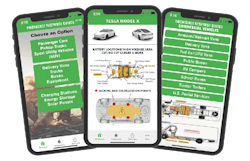The Latest in EV Lithium-Ion Battery Fire Mitigation for Firefighters
Key Takeaways
- There is not a single solution on how to mitigate fires from lithium-ion batteries in electric vehicles.
- Strategies and concerns will continue to change as car manufactureres continue to release different electric vehicles.
- Tools and knowledge from Ziamatic, Bridgehill, EV Rescue App, Turtle Fire Systems and Toxic Suppression can help mititgate li-ion incidents.
The lithium-ion (li-ion) battery fire discussion has been at the forefront of the fire service for nearly a decade now, and there still isn’t a clear solution. The complexity of li-ion batteries and incident mitigation has companies and people going back to square one time and time again.
Considering that these batteries have emerged as a popular power source for automobiles, power tools, smartphones and numerous other consumer products, it makes it even more difficult to find a one-off solution for when the batteries catch fire.
The risks of the chemical composition and the gases that get released, the batteries’ ejection from a battery pack, the risk of reignition and the thermal runaway are all things to be contemplated when dealing with a li-ion battery fire.
Then, there are the many solutions that have gone to market or are being proposed. Under-vehicle nozzles, fire blankets and direct water suppression are just three that have been hot topics of late. For example, the Fire Protection Research Foundation, which is the research affiliate of NFPA, and Fire Safety Research Institute (part of UL Research Institutes) recently released a statement about the hazards that come with utilizing a fire blanket. The organization’s experiments showed that despite denying oxygen to a li-ion battery fire, thermal runaway continued to be an issue. This and the risk of explosion when re-exposing the fire to oxygen are concerns when it comes to using a blanket.
There also is the issue of money and personnel. Each fire department is different in how many people that it can have on scene and how much money that it can give to training and various tools to mitigate those incidents.
Thus, mitigation of li-ion battery fires is an ongoing battle. Different tools will be developed, and different strategies and tactics will be conceived.
Fire blankets
Bridgehill, which is based in Norway, jumped into the fire blanket game 11 years ago. Because of the heavy commitment to electric vehicles (EVs) in the country, this was a necessary mitigation strategy. Eventually, it led to Bridgehill’s Car Fire Blanket and Lithium Fire Blanket.
One of the big things that Bridgehill emphasizes is that the weak point of any blanket is its coating, which is why the company continues its development efforts in that area. Additionally, its blankets include a center stripe, so first responders can place the blanket over the fire in the best position.
Also, all four of the handles that are on the blankets are a different color, so it’s easier for the firefighters to maneuver the blanket.
Important as these design matters seems to be, there are opinions on both sides of whether to use just a blanket, to use a combination of a blanket and water, or to just use water.
Water systems
Different water solutions for automobile li-ion battery fire mitigation come from Turtle Fire Systems, with its regular and Mini Turtle Fire Systems, and Ziamatic, with its Vehicle Cooling Unit (VCU).
The Turtle Fire Systems were created by Founder/CEO Howard Hayes and the company's team based on personal experience. COO/head of sales Matthew Faden and few other team members belong to the Jersey City, NJ, Fire Department.
The catalyst for them creating the dome-shaped nozzle was a fire at an automobile manufacturer that didn’t go as smoothly as people would’ve thought, beacuse there was a recognition that EV fires with the li-ion batteries weren't something the fire service was used to. The team took to the drawing board. Numerous tools were prototyped and tested. Being capable of having the most efficient water coverage and having a nozzle that wouldn’t break under pressure were two major focuses in continued development of the products.
Faden believes that fire departments are mistaken when they expect to find one end-all-be-all solution. “There are multiple tools,” he tells Firehouse, “and you have to find out what makes them all useful and whether they’re useful for your department.” Then comes the training, he explains.
The dome-shaped structure of Turtle Fire Solutions’ devices allows for continuous flow of water underneath a vehicle. Hole size and placement are to delivering the right amount of water and direction for suppressing the fire as safely as possible.
A steel pipe that’s connected to the nozzle provides leverage for deployment and a heat barrier to help to protect the hose and firefighter and ensures that the water flow is maintained should the tires fail and the vehicle drop.
The Elizabeth, NJ, Fire Department (EFD) utilizes the Turtle Fire System. The agency’s response district includes Newark Liberty International Airport. The airport’s parking structure has multiple floors of EV charging stations.
EFD Battalion Chief Patrick Wirkus is impressed with the system’s durability and potential for high GPM flows. “We really like the fact that not only could it be used for EV fires but also for exposure protection as well as commercial occupancy,” Wirkus adds. “The versatility, ease of use and durability were big reasons the members chose it.”.
The Mini version of the system came to be after an automobile manufacturer asked to shrink the dome of the original device and remove the slide plate and handles to allow mounting in the ground in the parking bays at one of its EV manufacturing facilities.
Ziamatic’s Vehicle Cooling Unit has seven different models. The VCU-36-NH can be utilized to cool the li-ion battery during an EV fire.
The 36-inch unit can be lengthened to 72-inches via a connecting adapter. It has a 140-degree spray pattern, 83 holes per 3-foot section and a 5½-inch ground clearance.
The VCU-36-NH recently was tested by the Waterbury, CT, Fire Department (WFD). A live burn was conducted with two vehicles, started with hay and wood. The VCU-36-NH was placed underneath the two vehicles at two different positions and angles—first, directly underneath the passenger area, and second at a 45-degree angle from the front of the vehicle underneath the engine.
Before the VCU-36-NH was moved into position, a thermal imaging camera showed intense heat in the engine area. Within minutes of spray commencing, the thermal imaging camera showed much less heat.
Protocols and knowledge
The Spartanburg-Pruitt Protocol was developed by equipment maker Toxic Suppression and former Spartanburg, SC, Fire Department Battalion Chief Matt Pruitt. In a nutshell, the protocol for EV fires says to knock down the fire, apply a fire security blanket and insert an under-the-vehicle nozzle.
Pruitt and Toxic Suppression connected in 2023 over their mutual concern for parking structures and EV fires.
“I started to think, if I was out on the on the street back in the day, what would I do?” Pruitt explains. “Why are we doing it the way we're doing it? Why don't we just deal with what we know how to deal with, and that's the vehicle itself.”
Pruitt worked with Toxic Suppression to tweak the products that already were in use. That resulted in something that differentiates the Toxic Suppression nozzle from others, given that it can turn into a door-hanging nozzle.
Of course, none of these tools that are noted above can be used without proper knowledge. That’s where the EV Rescue App comes into play.
Scott Saal and Phil Scarfi developed the app in 2021 as a place where first responders can access information about EVs, from emergency response guides to the placement of the battery.
Going to an automobile manufacturer’s website can take a lot of time when time is of the essence. The free to download app puts all of the information involving EVs and hybrid vehicles, bigger rigs, charging stations, heavy equipment and Amazon vans in one place.
The app is updated nearly every week, and about 15,000 departments utilize it. One of those is the Wilmington, NC, Fire Department (WFD).
“There's nothing like it,” Capt. Vance Casey tells Firehouse. “It’s all at your fingertips. I was blown away when I first started looking at it. It’s amazing that it’s a free app.”
Casey is in the process of getting the app downloaded onto all tablets on every WFD apparatus. He recalls a situation where a car ended up half-submerged in a pool after crashing. Members quickly accessed the emergency response guide that’s within the app to get the situation under control quickly.
Things will change
As results from research that is being conducted by the NFPA, Fire Safety Research Institute and other organizations comes out later in 2025, strategies will evolve and products will be tweaked or developed entirely new. Department's focus should be on acquiring that knowledge, doing what’s best for the community and continuing to understand that adaptation is a necessity.
About the Author

Ryan Baker
Ryan Baker is a writer and associate editor with prior experiences in online and print production. Ryan is an associate editor for Firehouse with a master's degree in sciences of communication from the University of Wisconsin-Whitewater. He recently completed a year of teaching Intro to Public Speaking at UW-Whitewater, as part of his graduate program. Ryan acquired his bachelor's degree in journalism in 2023 from UW-Whitewater, and operates currently out of Minneapolis, MN. Baker, also writes freelances for the Ultimate Frisbee Association (UFA) in his free time, while also umpiring baseball for various ages across the Twin Cities Metro Area.




